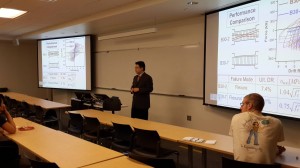David Friedman, Forell/Elsesser: RETROFIT OF CALIFORNIA MEMORIAL STADIUM
Protecting and Strengthening a Landmark on an Active Earthquake Fault
UC Berkeley’s California Memorial Stadium, constructed in 1923 and designed by the renowned architect John Galen Howard, sits directly over the northern segment of the active Hayward Fault. Situated at the opening of Strawberry Canyon, with the eastern half of the stadium literally carved into the hillside, the non-ductile concrete frame western stadium bowl was seismically retrofitted and modernized with new seating bowl framing, a new press box, and with the preservation and restoration of the historic perimeter concrete wall.
One of the unique features of the retrofit design was the approach to the sections of the stadium positioned over the north-to-south running, right-lateral Hayward Fault. The retrofit design creates separate “fault rupture zone blocks”, gapped and separated by joints from the adjacent sections of the stadium. The FRB’s are reinforced with stiffening concrete shear walls bearing on a mat slab foundation, all bearing on layers of sand and high-density plastic to reduce friction and thus facilitate the independent sliding, twisting, and tilting that may result from the predicted 6 feet of horizontal fault rupture displacement and 2 feet of vertical fault rupture displacement.
Ady Aviram, Simpson Gumpertz & Heger:Seismic Performance Enhancement Strategies in Reinforced Concrete Bridges
Improved seismic performance and cost-effectiveness of two innovative technologies in typical reinforced concrete bridge construction in California were assessed in an analytical and experimental study. The technologies considered were high-performance fiber-reinforced concrete bridge columns and seismic isolators placed beneath the bridge superstructure. Biaxial cyclic tests were conducted to characterize fiber-reinforced concrete column behavior, constructed using steel fibers and special reinforcement details for the plastic hinge region. Several seismic isolation solutions were used for the redesign of a five-span, single-column bent bridge including single, double, and triple friction pendulum bearings, as well as lead rubber bearings. Nonlinear response history analyses were conducted for the different bridge models in OpenSees using 140 ground motions of varied seismic intensity and characteristics. The PEER Center performance-based earthquake engineering methodology was used to compute the post-earthquake repair cost and time of the bridge systems over their lifespan. Analysis results demonstrated that despite slightly higher initial construction costs, considerable economic and structural benefits can be obtained from the use of the two techniques, especially the isolation of the bridge superstructure. Experimental results established the improved damage-tolerance, shear strength, and energy dissipation of fiber-reinforced concrete columns under cyclic loading, compared to conventionally-reinforced concrete elements.
Erwin Lim, National Taiwan University: Seismic behavior of coupling beams
David Friedman (Left) and Erwin Lim (Right) on EERI Presentation


